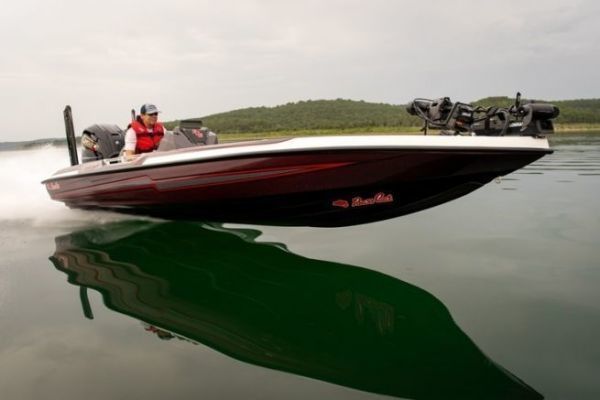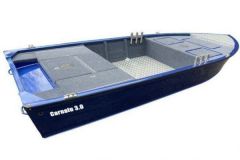Trim on a bassboat
First, let's look at the mechanics and the basic principle. Trim is a hydraulic system that raises the engine by a few degrees while sailing. Don't confuse it with tilt, which is another hydraulic system that raises the motor out of the water, but only at standstill or at very low speed. The noise of the hydraulic pump differs for these two functions, making them easier to distinguish.
When the motor is in the down position, the thrust is horizontal, which is ideal for making the boat rise quickly. The entire length of the hull is in contact with the water, producing a big wave and making steering difficult. This is when a little trim is applied. As it pivots, the motor pushes down, acting like a lever with the bottom of the hull as its pivot point. Because of the speed, the water resists the pressure and the rear of the boat cannot sink into the water, which lifts the front of the boat.

As the propeller rises, the contact area with the water decreases, speed increases and steering becomes fluid. If the propeller is correctly selected, engine speed should reach or slightly exceed 6000 RPM, bringing the boat up to maximum rpm. If you want to sail more slowly, you won't be able to use as much trim, which is proportional to speed. The principle also applies to deep-V boats, although the trim range is generally shorter than on bassboats.
The right settings
If you apply too much trim to your engine, the following phenomena may occur:
- Gerbe d'eau (rooster tail) it should not exceed approximately the height of the motor.
- Cavitation the propeller absorbs too much air and the motor runs away.
- Marsouinage the boat hops like a dolphin.
- China walk the boat oscillates from left to right. Experienced pilots can counter this phenomenon with the steering wheel.
In all cases, the solution is to lower the trim by a few degrees.

You might be tempted to think that the more trim you apply, the better. In reality, the opposite is true. Applying too much trim will propel a big spray of white water behind the boat, which does nothing to increase speed. Some heavier boats need more trim. This is one of the reasons why Basscat offer better performance: they emerge completely from the water with less trim.
Note that the effect of trim on the boat's behavior is not immediate, so take your time. Similarly, when decelerating, retract the trim before reducing throttle.
The trim is the main tool for adjusting your boat's behavior according to the situation: slowing down to meet another boat's wave, taking a turn, sailing in heavy weather, etc. Every boat is different. Every boat is different, so take the time to familiarize yourself with its behavior and get a good feel for it!

 /
/ 









